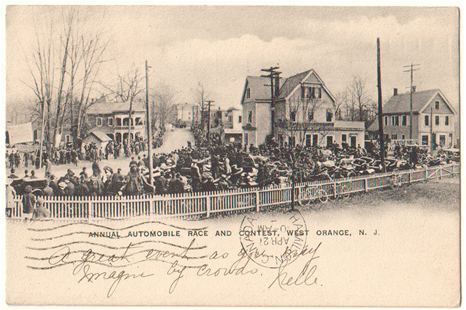History of West Orange, NJ

This circa 1903 Postcard shows the “Annual Automobile Race and Contest”, an interesting commentary on just how quickly the Automobile became popular in West Orange. The large building in the center still stands and houses the West Orange Pharmacy. Main Street is at right, Eagle Rock Av at left, and Harrison Av straight ahead.
Written by: Wikipedia, the free encyclopedia and www.FirstBaptistBloomfield.org
West Orange was initially a part of the city of Newark, and remained so until November 27, 1806, when the territory now encompassing all of the Oranges was detached to form Orange Township. On April 13, 1807, the first government was elected. On January 31, 1860, Orange was incorporated as a town, and on April 3, 1872, it was officially incorporated as a city. Almost immediately, Orange began fragmenting into smaller communities, primarily because of local disputes about the costs of establishing paid police, fire, and street departments. South Orange was organized on April 1, 1861, Fairmount (an independent municipality for less than one year that was later to become part of West Orange) on March 11, 1862 and East Orange on March 4, 1863. West Orange (including what had been the briefly independent municipality of Fairmount) was formed as a township on April 10, 1863, and was reformed as a town on February 28, 1900.
Llewellyn Park, the first planned community in America, is located within West Orange, and was designed by entrepreneur Llewellyn Haskell and architect Alexander Jackson Davis in 1857. Llewellyn Park is considered among the best examples of the “Romantic Landscape” movement of that period. Thomas Edison was one of the many residents.
Circa 1905 – Just below Eagle Rock Reservation. This photo shows the tracks of the Eagle Rock Trolley on Mountain Rd as clearly seen on the US Topo map revised in 1897. The start of the “100 Steps” are seen at right.
Photo circa 1904 – Eagle Rock Trolley, a short line that ran from the intersection of Main St & Eagle Rock Av up to Under Cliff Av at the bottom of the Reservation. Photo shows the vicinity of Nutwold Av.
The lookout at Eagle Rock Reservation in the 1930s. This area overlooking the New York City skyline is now the site of the newly dedicated Memorial to the 3,000 people murdered by Terrorists on September 11.
Mitchell’s, the Crystal Lake Hotel, in its’ prime, circa 1900. The area was re-developed around the year 2000 with a Townhouse & Office complex.
Thomas Alva Edison poses in his West Orange Laboratories circa 1925, underneath, of course, a light bulb, which he invented. The most famous resident of West Orange, Thomas Edison lived here in ‘Glenmont’, his home in the private enclave of Llewellyn Park from 1886 until his death in 1931.







